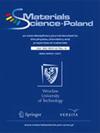MgO和Al2O3对高铝水泥高温稳定性能的影响
IF 1.1
4区 材料科学
Q3 Engineering
引用次数: 0
摘要
高铝水泥以其良好的高温性能在耐火材料中占有重要地位,但其强度倒置、水化产物转化不稳定等缺点一直制约着其发展。为了阐明高铝水泥的工作机理,提高其耐高温性能,在高铝水泥浆中加入了MgO和Al2O3。采用优化设计方法确定了各因素对水泥浆体高温稳定性的影响。对原材料的配合比进行了优化,验证了在最佳配合比下试件的强度变化规律。从微观结构的角度,使用X射线衍射、扫描电子显微镜、热重分析和差示扫描量热法研究了高铝水泥硬化浆体的高温演化。结果表明,引入耐火材料粉末,特别是Al2O3,可以显著提高水泥浆体在高温下的体积稳定性。当水灰比为0.20,MgO掺量为5%或10%,Al2O3掺量为20%时,水泥浆体的高温体积稳定性最好。然而,随着煅烧温度的升高,其相应的机械强度在一定程度上减弱。此外,通过微观结构表征,特别是粉末对高温下水泥块体积和强度的影响,验证了高温煅烧条件下渗碳体的结构性能演变过程。该研究结果可为开发高铝水泥及其胶结材料以及改善其性能提供指导。本文章由计算机程序翻译,如有差异,请以英文原文为准。
Effect of MgO and Al2O3 on High-temperature Stability Performance of High-alumina Cement
High-alumina cement has an important position in refractory materials with its good performance at high temperatures, but its disadvantages such as strength inversion and unstable transformation of hydration products have always limited its development. To clarify the working mechanism of high-alumina cement and improve its high temperature resistance, MgO and Al2O3 were added to the high-alumina cement paste. The optimal design method was used to determine the influence of each factor on the high temperature stability of the cement paste. The mix ratio of raw materials was optimized and the strength change patterns of the specimens under the optimal ratio were verified. From a microstructure perspective, the high temperature evolution of the hardened paste of high-alumina cement was explored using X-ray diffraction, scanning electron microscopy, thermogravimetry, and differential scanning calorimetry. The results show that the introduction of refractory powders, especially Al2O3, can significantly improve the volumetric stability of the cement paste at high temperatures. When the water-cement ratio is 0.20, the admixture of MgO is 5 % or 10 %, and Al2O3 is 20 %, the high temperature volume stability of the cement paste is the best. However, its corresponding mechanical strength is weakened to some extent with an increase in calcinating temperature. Moreover, the structure-property evolution process of cementite under high temperature calcinating conditions was verified by microstructural characterization, especially the influence of the powder on the volume and strength of the cement block at high temperatures. The results of this study can serve as a guide for the development of high-alumina cement and its cementing materials, as well as for the improvement of their properties.
求助全文
通过发布文献求助,成功后即可免费获取论文全文。
去求助
来源期刊

Materials Science-Poland
工程技术-材料科学:综合
CiteScore
1.70
自引率
18.20%
发文量
0
审稿时长
6.2 months
期刊介绍:
Material Sciences-Poland is an interdisciplinary journal devoted to experimental research into results on the relationships between structure, processing, properties, technology, and uses of materials. Original research articles and review can be only submitted.
 求助内容:
求助内容: 应助结果提醒方式:
应助结果提醒方式:


